Caladium, or elephant ear plants, have a stunning range of foliage, perfect as a houseplant, or for groundcover in the garden. Their vividly coloured, heart-shaped leaves can be found in a whole host of different colours, with a gorgeous metallic sheen covering many cultivars.
Caring for caladiums is actually pretty straightforward, provided you treat them right and get to know their needs. Follow our in depth guide to growing and caring from caladiums below to maintain healthy happy plants wherever you might be, or wherever you want to grow them.
More...

Family: | Araceae |
|---|---|
Genus: | Caladium |
Common Names: | Elephant Ear, Angel Wings, Heart of Jesus |
Location: | Indoor and outdoor |
Type: | Herbaceous flowering perennial |
Growth: | 40-90cm tall |
Sun requirements: | Bright indirect light |
Foliage Colour: | Green, white, Orange, Pink, Red, Purple, etc. |
Flower Colour: | White or cream |
Flowering: | Early summer |
Fruit: | None |
Maintenance level: | Low |
Poisonous for pets: | Non-toxic to cats and dogs |
What are Caladiums?
Caladium is a wide genus of flowering plants, grown mainly for their foliage colour. There are around fourteen recognised species, but within each there are many unique cultivars. Caladium bicolour is the most widely cultivated, with over 1000 named varieties under its wing.
The tuberous roots of caladiums make them easy to divide and help them to spread through loose fertile soil as ground cover easily, but they are not frost hardy, so any part of Australia with winters below 18°C require gardeners to move caladiums indoors to overwinter.
Caladium’s Natural Habitat
All species in the Caladium genus are native to tropical South America (Colombia, Brazil, Costa Rica, Venezuela, Guyana, Peru, Ecuador and northern parts of Argentina). They have naturalised outside that area in similar climates including India and parts of Africa, and grow well in Australian gardens in the right conditions.
Open forests and river banks are their most common habitat, with managed humidity and regular but draining water. Through dry seasons, Caladiums will naturally go dormant and lose all foliage, but in Australia, that dormancy can be triggered by both drought and cold temperatures depending on where you are.
How to Grow Caladiums in Australia
Caladiums can be grown as houseplants, and in exceptionally dry parts of Australia tend to grow better indoors, with more care given to their moisture levels. However, growing caladiums outdoors in Australia is by far the best way to make the most of their stunning foliage and create swathes of impactful planting.
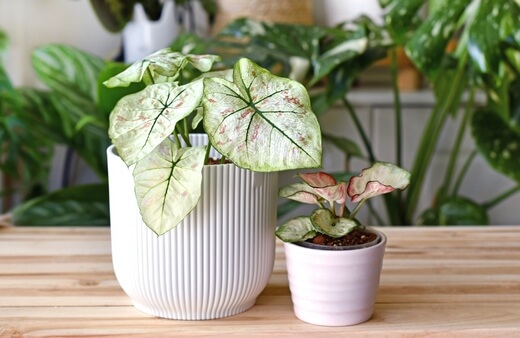
Grow Caladiums Indoors
Growing caladiums in a pot is relatively simple. Give them moist, but not saturated soil, and make sure the potting mix drains well, while holding some vital moisture so it never dries out completely.
For a single caladium plant, you’ll need a pot that’s at least 20 cm in diameter, and the same depth. Fill the pot with a draining, but slightly moisture-retentive compost mix (I recommend 60% organic compost and 40% vermiculite).
- Leave enough space for the existing root ball of your calcium, and gently place it in the pot, before gently filling compost around the edge.
- After filling the container, water it really well so water is dripping out of the base of the pot. This will settle the roots into their new home, and let you focus on positioning, rather than watering for the first couple of weeks.
- Find a well-lit spot, ideally with 6-8 hours of indirect light per day.
- Water indoor caladiums once every two weeks, or whenever the soil surface is starting to dry out.
How to Grow Caladiums Outdoors
Outdoor caladiums are slightly harder to care for, planting is just the same. As with indoor caladiums, which need 20cm of space per plant, you should space each outdoor caladium 20-30cm apart. They will quickly fill the gaps.
Choose a bright spot, with moisture-retentive, but not boggy conditions, and add rich compost or rotted manure to the planting hole. This is more for moisture retention than nutrients, so it’s ok to use spent compost here.
Prepare a hole that is at least twice as wide, and twice as deep as the caladium’s root ball, and gently pull soil and compost back in around the base of the plant so it sits level with the soil. Water it in well to settle the soil rather than firming it by hand.
For the first few weeks after planting, water your caladiums every few days so that it doesn’t dry out, then add a 1-2” layer of mulch (bark mulch is perfect) to help hold in moisture through summer.
Propagating Caladiums
Caladiums grow from tubers, not bulbs, as much of the internet claims. Tubers are similar to bulbs, but are more like energy storage facilities at the centre of the root. Like any plant that grows from tubers, caladiums can be propagated from tubers in autumn, winter and spring, but they are also fairly simple to grow from seed if you find a good supplier.


Get Your Free Guide:
Master Growing Australian Natives eBook
A Must Have Complete Guide for Every Australian Garden
Get Your Free Guide:
Master Growing Australian Natives eBook
A Must Have Complete Guide for Every Australian Garden
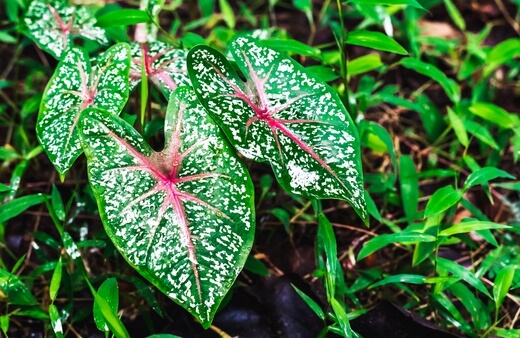
Below, we’ve got guides on how to grow caladiums, depending on what you’re starting with.
How to Propagate Caladium from Seeds
Some caladium cultivars are expensive as a result of their rarity, so buying a full border’s worth of plants can be heavy on the wallet. However, propagating caladiums from seed is relatively straightforward, and made even easier by late spring conditions in most of Australia.
Dried caladium seeds are fine to use with no preparation, and work just as well as fresh seeds. All they need is light, moisture, and a little bit of time.
- Start by filling a seed tray with sieved garden soil, or mix sieved compost with perlite for similar conditions.
- Then, sprinkle caladium seeds over the surface of the soil at about 4 cm apart (this isn’t important, but it will make them easier to handle later).
- Do not cover the seeds as they need direct light to germinate.
- Keep the seed tray somewhere warm and bright, and make sure it doesn’t dry out completely.
- To maintain moisture, cover the seed tray with cling film.
- Germination can take as little as two weeks, so keep checking them.
- Once your seedlings have germinated, remove any coverings so they can breathe, and keep the soil moist but not damp.
- When each seedling is 2” tall or more, transplant them gently into individual pots of well-drained soil or compost.
- Store the young plants anywhere bright and warm, and move them away from direct sunlight to reduce stress. After about two months you should have young caladiums that are strong enough for their forever homes, but caring for them in containers for their first year will allow them to develop full tubers, so they are more likely to survive winter chills.
Caladium Propagation from Tubers
Caladiums can be propagated from their tubers, but in a different way than most tuberous plants. They don’t readily sprout from their tubers but are capable of it.
If you’re lucky, you’ll have several plants in one pot that can easily be split, if not, you’ll need to put in a little more effort.
To propagate caladiums from un-sprouted tubers:
- Start by removing your plants from their containers, and shaking off the soil.
- This is best done in winter or late autumn when they are largely dormant.
- Remove as much as 1/3 of the tubers from the peripheries of the plant (the parent plant will grow happily again next year, and potentially with more vigour as a result)
- Find any ‘eyes’ on the tubers, similar to potatoes, or nodes along stems, that look like they have the potential to sprout, and split the cut tubers into sections that are about 4 cm across as a minimum (bigger is ok).
- Leave these tubers to callous for two days so their cut surfaces begin to heal and reduce the risk of fungal infections.
- Plant each tuber into its own pot, and leave it somewhere warm, in lightly moistened soil until spring. In spring, move each pot out into the light, and water them as soon as you see signs of new shoots.
- Then simply treat them like you would treat any other caladium.
Caladium Care Guide
Caladium care depends on the soil conditions, locations, and maturity of each plant, but there are some things that transcend all of that, and should be observed no matter where you are, or how old your plants are.
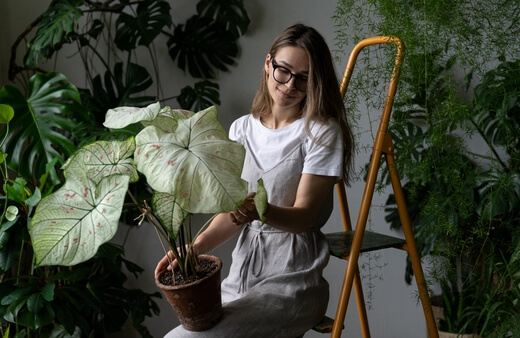
Overwintering caladiums
In Australia, there are two scenarios that can trigger dormancy; drought and cold. In nature, caladiums grow in hot, damp, tropical regions, and go dormant when the hot summers stop raining. In Australian gardens, you can prevent that simply by keeping their soil moist through summer.
However, in nature, caladiums rarely live in climates that drop below 15°. So our winters can be challenging. In eastern or northern parts of the country, and some central regions, it’s fine to grow caladium outdoors all year round. In others, it’s worth digging them up and storing the tubers in dry, dark conditions over winter.
If you’ve got caladiums in pots, simply move them into a shed, or into the house for winter, where they can continue to display their gorgeous foliage, without suffering from winter colds.
Fertilising Caladiums
Young caladiums can be shocked by fertilisers, so use them very diluted, and rarely until your plants are properly established. For mature caladiums, any foliage feed or house plant fertiliser will do the trick. Just make sure they aren’t overfed.
I tend to feed my indoor caladiums about once a month, with a soluble feed in water. My outdoor plants rarely get fed as the soil is rich enough, but an annual mulch or granular feed will give plants a boost on poor soils.
Pruning Needs
Caladiums are statement plants, and like any garden statement, they should look their best all year round. So as a rule, I always prune out any damaged, dead, or diseased-looking stem by cutting it right to the base.
Not only does this improve the look of the plant, but it reduces foliage humidity levels, and prevents the spread of diseases. Do this whenever you notice patches, brown lesions, or damage on a leaf as it won’t recover properly. Do the same with any darkened stems, of old foliage that has begun to die back.
Repotting Caladiums
Caladiums in containers are not particularly fast growing, but like any containerised plant, they will need a refreshed batch of compost every two or three years.
Signs that a caladium needs repotting include yellowing foliage, or dry top growth. Especially if the soil remains moist as this can be a sign of either root rot, or root restriction, preventing the natural uptake of nutrients.
When repotting or replanting caladiums, shake off all the old compost, and replant into completely fresh soil. Pot on to a container no more than 10 cm larger than the old one to prevent boggy conditions around the roots.
Caladium Pests and Diseases to Look Out For
Caladiums are more prone to diseases than pests but, as I’ll explain below, there are still a few common garden pests that can harm your prized foliage.
Insects
Aphids, mealybugs, spider mites, scale insects, and thrips are the only common caladium pests. Like all plants, most of these pests are actually a sign of a healthy plant that’s attracting bugs to eat its abundant chlorophyll. However, if you notice spider mites, the most likely cause is dry soil.
If any pests are significantly affecting your caladiums, amend your watering routine, and spray them off with a powerful spray nozzle on your hosepipe. Refer to our guides below about the pests mentioned above for more info.
Mammals
Despite caladiums being incredibly toxic to almost all species of mammals, for some reason they are also incredibly attractive to wild mammals. If you have any herbivorous pests living near you, consider spraying caladiums with garlic, or chilli teas to put them off.
Fusarium root rot
Caused by Fusarium solani, Fusarium root rot is a fungal pathogen that exists in most cultivated soil and affects most fleshy-rooted plants. The fungus thrives in warm moist soil, where moisture doesn’t drain, and is particularly difficult to manage in Caladium planting beds due to the moisture requirements. Providing good drainage to match moisture retention is a must.
Dasheen mosaic virus
Dasheen mosaic virus is particularly prevalent in densely planted areas of caladium and similarly leafed plants, spreading through touch, insect movement, and within infected plants.
As the name suggests, initial signs are mosaic patterned marking across the leaves. To prevent spread, remove affected foliage immediately.
Pythium Crown and Root rot
Pythium spp. is a family of soil borne pathogens, until recently classed as a fungus, but they are in fact parasitic oomycetes (which work in near identical ways, so you’d be forgiven for the misunderstanding).
The symptoms are mushy roots, and mushy crowns or plants, as the root rot is hard to spot until it climbs up the plant to destroy the top growth. Remove any affected plants and attempt to remove any diseases materials.
It is possible to rectify infected plants by harsh pruning, but keep them separate from others until you’re sure.
Rhizoctonia solani
Another root rot that is particularly efficient at damaging caladiums is rhizoctonia. The overall effect is similar to pythium rot, but with one key difference. Rather than creating a wave of mushy rot, it spreads in brown lesions in its early stages, and is often limited to one side of the plant.
Treatment will mean removing the infected section and burning it, and keeping an eye on the rest of the plant for a few weeks while keeping the soil as dry as possible to prevent spread.
20 Best Caladiums to Grow in Australia
Pretty much every Caladium variety will grow happily using the conditions in this guide, but there are a few tricky little outliers that like to grow a little differently. So, as well as pulling together a list of our favourite varieties of caladium, we’ve put together some basic information about how, when, and where to grow each one if it’s a bit different from the norm.
1. Caladium ‘Allure’Allure caladiums have a gentle crispness to them which is really quite hard to find in the natural world. Like most varieties in this list, it is not a species-specific Caladium, and has been bred for its relatively hardiness, and easy growing habits. | 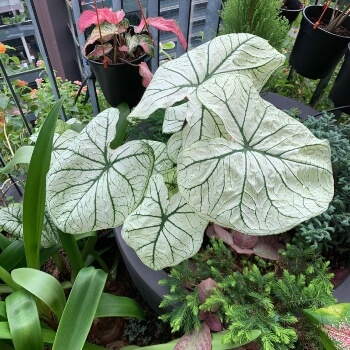 Source: Carousell |
2. Caladium ‘Carousel’Caladium ‘Carousel’ might not be a naturally occurring variety, but its organic dapples of red along its leaf veins, bordered with splashes of white within the bold emerald leaf edges are truly stunning. If you want a more organic effect for your garden borders, there are few more striking or natural looking cultivars. | 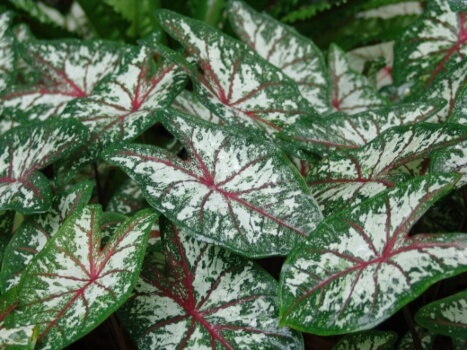 Source: PartygardenCo |
3. Caladium ‘Celebration’Celebration caladiums follow well from Caladium ‘Carousel’ as they have clear similarities, but harshly contrasting forms. Their colouring is near identical, but the pointed foliage of Caladium ‘Celebration’ has a much more tropical feel, which would look incredible alongside any running water feature in the garden. |  Source: MyPlantObsession |
4. Caladium ‘Crystal Moon’I’ve thrown this in, not because it’s one of the most popular, but because it’s my personal favourite. The intricate green edging, and delicate green veins that give Caladium ‘Crystal Moon’ its structure make them so much more appealing than any pure white caladium could ever be. The near cartoonist foliage has the perfect blend of nature and human intervention stamped across every leaf. | 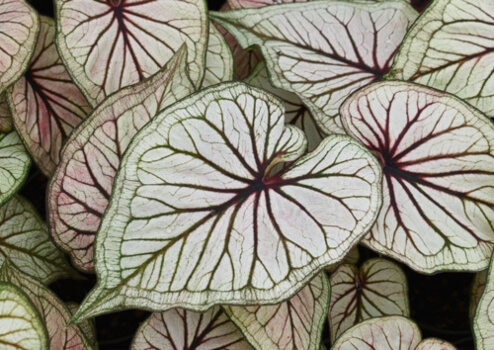 Source: Classic Caladiums |
5. Caladium ‘June Bride’You’ll probably notice the difference between Caladium ‘June Bride‘ and Caladium ‘Crystal Moon’ here quite easily. June Bride is where caladium breeders began to aim for ‘purity’, finding the simplest colouring possible, and breeding out the veining or borders to the foliage. I see the appeal of this vivid display, but personally prefer a little bit more structure. |  Source: BlueBuddhaFarm |
6. Caladium ‘Monument’The crinkled foliage of Caladium ‘Monument’ gives it its name, mimicking stone work through shadowing and texture like no other caladium can. The way shadows play across these leaves in the evening is just stunning and work beautifully in containers on patios, particularly as the moonlight casts those clear summer shadows over the pale foliage. | 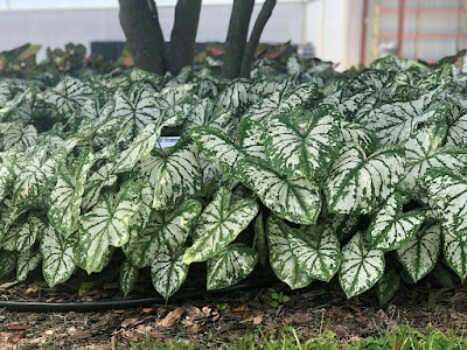 Source: Travaldo's blog |
7. Caladium ‘Snow Drift’Caladium ‘Snow Drift’ is another white-leave caladium, which fits neatly into most garden designs particularly as a path border for that practical evening white that guides visitors through the garden as light fades into night. The crinkled foliage pairs well with the more rigid white colouring. | 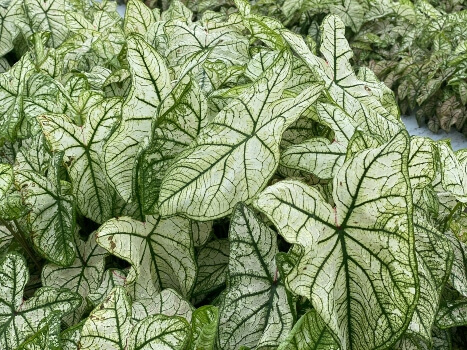 Source: Classic Caladiums |
8. Caladium ‘Strawberry Star’There’s nothing like a plant that doesn’t stick to rules. I’ve had a few Caladium strawberry stars over the years, and they’ve all ended up being gifted to friends, who’ve fallen in love with them. For me, the excitement comes from the difference between each and every plant. No Strawberry Star Caladium is ever quite identical, with more red, or clearer speckles that change based on soil conditions, light conditions, and the time of year. If you want the unexpected, go for this beauty, whose foliage always provides something new to look at | 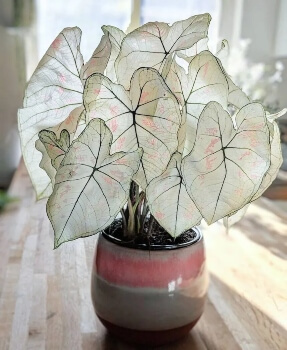 Source: PlantIn |
9. Caladium ‘White Butterfly’Caladium ‘White Butterfly’ has leaves that are similar to, if you’re familiar with them, begonias. Their curved, spiralled bases overlap around each leaf’s stem, and accentuate their form with dark green borders creating a stunning depth. In my experience, Caladium ‘White Butterfly’ is also one of the best-adapted cultivars to cope with slightly drier conditions. | 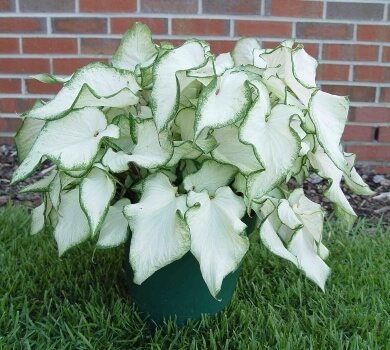 Source: Classic Caladiums |
10. Caladium ‘White Majesty’Caladium ‘White Majesty’ always strikes me as a plant that was aiming for something but never quite got there. And I don’t mind it. The fact that they’re paler green, rather than white, makes them feel more honest, and helps them settle into a wider range of planting than most strictly white caladiums, and their ever-so-slightly yellow hue adds a sunny smile to the border. |  Source: Greg |
11. Caladium ‘White Diamond’White Diamond Caladiums make the most of their veining, with a distinct lack of pigment on any vein, no matter how small, creating an intricate web of white across the verdant leaves. There's nothing quite like a plant that helps you connect deeply to nature and take the time to understand its inner workings. | 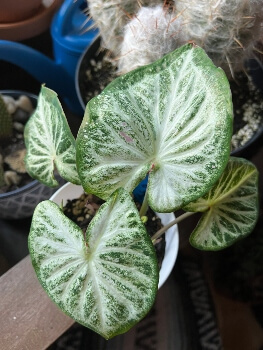 Source: BlueBuddhaFarm |
12. Caladium ‘White Cranberry Star’If you don’t fancy the ambiguous and unpredictable nature of Caladium Strawberry Star, try Cranberry Star instead. Its red speckles are much more predictable, and beautifully dotted across each leaf all year round. They might not be the most natural addition to a garden, but they certainly add a bit of fun to planting schemes. | 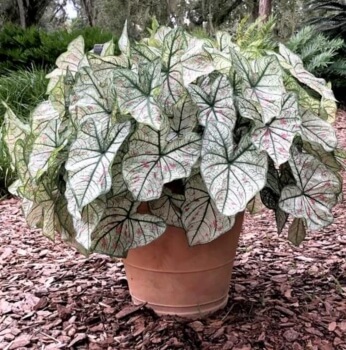 Source: PartygardenCo |
13. Caladium ‘Bombshell’I can’t help but feel that Stan Lee is looking down in Caladium ‘Bombshell’ and wishing he’d been that bold with colour in his early days. There’s something extremely comic-book about the booming red that bursts out into the green borders with no apologies that makes these superb plants sign louder than any other Caladium in this list. |  Source: PartygardenCo |
14. Caladium ‘Blushing Bride’‘Blushing’ is one of those words that’s thrown around in plant names so often that it’s almost lost all meaning, but thankfully, whoever named Caladium ‘Blushing Bride’ got it spot on. The flush of colour across these green and white leaves feels exactly like the hot flushes of embarrassment, anxiety and envy that reddens our own cheeks and while the same effects might not be present in these leaves, it’s hard to separate them from our own blushes as the red blotches fade out into white. | 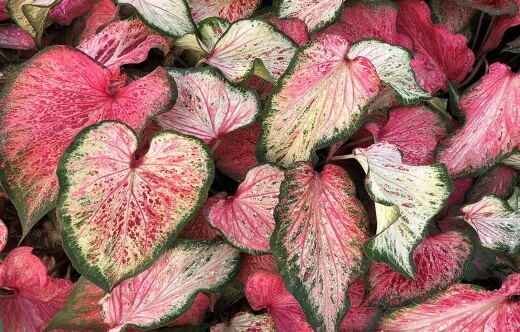 |
15. Caladium ‘Florida Sweetheart’Caladium ‘Florida Sweetheart’ is often passed by as a monochrome pink, but there is so much detail in the foliage of these translucent plants that they really do deserve more attention. The strict red veining runs through the leaf, and blocks out the light, while their salmon-pink body lets light pass through to the soil, and reflects the rest back at the sky. The overall effect might be a single coloured leaf, but up close there is stunning detail to be found in these tender caladiums. |  |
16. Caladium ‘Burning Heart’Remember that scene at the end of Lord of the rings where the ring bubbles into the lava? Caladium ‘Burning Heart’ has that same bubbling intensity on each and every leaf, with patches of translucent orange embedded into a rich, blood-red body. For autumn colours all year round, there is nothing more intense. | 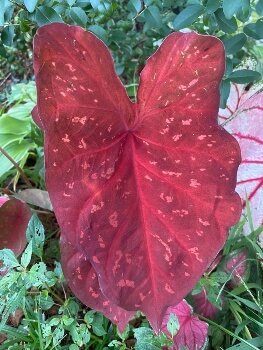 |
17. Caladium ‘Apple Blossom’Caladium ‘Apple Blossom’ gets its name from the shared pinks and reds that are so iconic to spring orchards, but as the year goes on, the veining on Caladium ‘Apple Blossom’ intensifies and booms out of the border, providing stunning ground cover, or a cosy patio plant. |  Source: Brent and Becky's Bulbs |
18. Caladium ‘Lemon Blush’As one of the hardiest caladiums there is, Lemon Blush should not be overlooked for any slightly more temperate garden. Surviving happily under the shaded canopy of deciduous trees, Caladium ‘Lemon Blush’ blends beautifully into other damp planting schemes, with ferns hostas and the rest to create a stunning forest floor effect, with more of a tropical feel. | 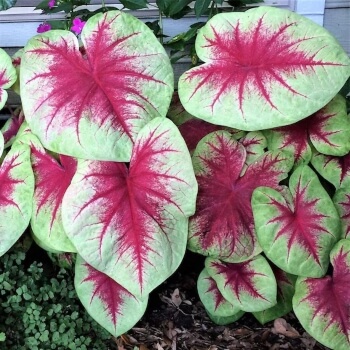 Source: MyPlantObsession |
19. Caladium ‘Hot Lips’Caladium ‘Burning Heart’ is quite hard to come by, so if you’re having trouble finding it, try Caladium ‘Hot Lips’, whose seeds are easy to come by online, and which is often sold in garden centres in the tropical section. They work better indoors, but will do fine outside in warmer parts of the country provided they are kept moist. | 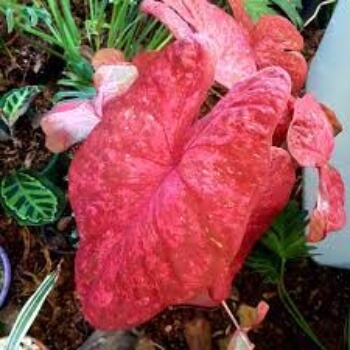 Source: GardenTags |
20. Caladium bicolorCaladium bicolor is one of the few Caladiums you can buy that is still connected to its species without having its DNA muddied by over cultivation. For a true Caladium that has the beauty of manufactured cultivars, with the benefits of natural selection, try these gorgeously large-leaved varieties. | 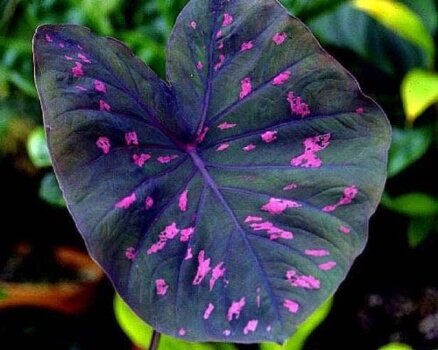 Source: AgriStarts |
20 Best Caladiums to Grow in Australia
Pretty much every Caladium variety will grow happily using the conditions in this guide, but there are a few tricky little outliers that like to grow a little differently. So, as well as pulling together a list of our favourite varieties of caladium, we’ve put together some basic information about how, when, and where to grow each one if it’s a bit different from the norm.
1. Caladium Allure

Source: Carousell
Allure caladiums have a gentle crispness to them which is really quite hard to find in the natural world. Like most varieties in this list, it is not a species-specific Caladium, and has been bred for its relatively hardiness, and easy growing habits.
2. Caladium Carousel

Source: PartygardenCo
Caladium carousel might not be a naturally occurring variety, but its organic dapples of red along its leaf veins, bordered with splashes of white within the bold emerald leaf edges are truly stunning. If you want a more organic effect for your garden borders, there are few more striking or natural looking cultivars.
3. Caladium Celebration

Source: MyPlantObsession
Celebration caladiums follow well from Caladium carousel as they have clear similarities, but harshly contrasting forms. Their colouring is near identical, but the pointed foliage of Caladium Celebration has a much more tropical feel, which would look incredible alongside any running water feature in the garden.
4. Caladium Crystal Moon

Source: Classic Caladiums
I’ve thrown this in, not because it’s one of the most popular, but because it’s my personal favourite. The intricate green edging, and delicate green veins that give Caladium Crystal Moon its structure make them so much more appealing than any pure white caladium could ever be.
The near cartoonist foliage has the perfect blend of nature and human intervention stamped across every leaf.
5. Caladium June Bride

Source: BlueBuddhaFarm
You’ll probably notice the difference between Caladium June Bride and Caladium Crystal Moon here quite easily. June Bride is where caladium breeders began to aim for ‘purity’, finding the simplest colouring possible, and breeding out the veining or borders to the foliage.
I see the appeal of this vivid display, but personally prefer a little bit more structure.
6. Caladium Monument

Source: Travaldo's blog
The crinkled foliage of Caladium Monument gives it its name, mimicking stone work through shadowing and texture like no other caladium can. The way shadows play across these leaves in the evening is just stunning and work beautifully in containers on patios, particularly as the moonlight casts those clear summer shadows over the pale foliage.
7. Caladium Snow Drift

Source: Classic Caladiums
Caladium snow Drift is another white-leave caladium, which fits neatly into most garden designs particularly as a path border for that practical evening white that guides visitors through the garden as light fades into night. The crinkled foliage pairs well with the more rigid white colouring.
8. Caladium Strawberry Star

Source: PlantIn
There’s nothing like a plant that doesn’t stick to rules. I’ve had a few Caladium strawberry stars over the years, and they’ve all ended up being gifted to friends, who’ve fallen in love with them. For me, the excitement comes from the difference between each and every plant.
No Strawberry Star Caladium is ever quite identical, with more red, or clearer speckles that change based on soil conditions, light conditions, and the time of year. If you want the unexpected, go for this beauty, whose foliage always provides something new to look at.
9. Caladium White Butterfly

Source: Classic Caladiums
Caladium White Butterfly has leaves that are similar to, if you’re familiar with them, begonias. Their curved, spiralled bases overlap around each leaf’s stem, and accentuate their form with dark green borders creating a stunning depth.
In my experience, Caladium White Butterfly is also one of the best-adapted cultivars to cope with slightly drier conditions.
10. Caladium White Majesty

Source: Greg
Caladium white Majesty always strikes me as a plant that was aiming for something but never quite got there. And I don’t mind it. The fact that they’re paler green, rather than white, makes them feel more honest, and helps them settle into a wider range of planting than most strictly white caladiums, and their ever-so-slightly yellow hue adds a sunny smile to the border.
11. Caladium White Diamond

Source: BlueBuddhaFarm
White Diamond caladiums make the most of their veining, with a distinct lack of pigment on any vein, no matter how small, creating an intricate web of white across the verdant leaves. There's nothing quite like a plant that helps you connect deeply to nature and take the time to understand its inner workings.
12. Caladium White Cranberry Star

Source: PartygardenCo
If you don’t fancy the ambiguous and unpredictable nature of Caladium Strawberry Star, try Cranberry Star instead. Its red speckles are much more predictable, and beautifully dotted across each leaf all year round.
They might not be the most natural addition to a garden, but they certainly add a bit of fun to planting schemes.
13. Caladium Bombshell

Source: PartygardenCo
I can’t help but feel that Stan Lee is looking down in Caladium Bombshell and wishing he’d been that bold with colour in his early days. There’s something extremely comic-book about the booming red that bursts out into the green borders with no apologies that makes these superb plants sign louder than any other Caladium in this list.
14. Caladium Blushing Bride

‘Blushing’ is one of those words that’s thrown around in plant names so often that it’s almost lost all meaning, but thankfully, whoever named Caladium blushing bride got it spot on.
The flush of colour across these green and white leaves feels exactly like the hot flushes of embarrassment, anxiety and envy that reddens our own cheeks and while the same effects might not be present in these leaves, it’s hard to separate them from our own blushes as the red blotches fade out into white.
15. Caladium Florida Sweetheart

Caladium Florida Sweetheart is often passed by as a monochrome pink, but there is so much detail in the foliage of these translucent plants that they really do deserve more attention.
The strict red veining runs through the leaf, and blocks out the light, while their salmon-pink body lets light pass through to the soil, and reflects the rest back at the sky. The overall effect might be a single coloured leaf, but up close there is stunning detail to be found in these tender caladiums.
16. Caladium Burning Heart

Remember that scene at the end of Lord of the rings where the ring bubbles into the lava? Caladium Burning Heart has that same bubbling intensity on each and every leaf, with patches of translucent orange embedded into a rich, blood-red body.
For autumn colours all year round, there is nothing more intense.
17. Caladium Apple Blossom

Source: Brent and Becky's Bulbs
Caladium Apple Blossom gets its name from the shared pinks and reds that are so iconic to spring orchards, but as the year goes on, the veining on Caladium apple blossom intensifies and booms out of the border, providing stunning ground cover, or a cosy patio plant.
18. Caladium Lemon Blush

Source: MyPlantObsession
As one of the hardiest caladiums there is, Lemon Blush should not be overlooked for any slightly more temperate garden. Surviving happily under the shaded canopy of deciduous trees, Caladium Lemon Blush blends beautifully into other damp planting schemes, with ferns hostas and the rest to create a stunning forest floor effect, with more of a tropical feel.
19. Caladium Hot Lips

Source: GardenTags
Caladium Burning Heart is quite hard to come by, so if you’re having trouble finding it, try Caladium Hot Lips, whose seeds are easy to come by online, and which is often sold in garden centres in the tropical section.
They work better indoors, but will do fine outside in warmer parts of the country provided they are kept moist.
20. Caladium rubicundum Bicolour

Source: AgriStarts
Caladium rubicundum Bicolour is one of the few Caladiums you can buy that is still connected to its species without having its DNA muddied by over cultivation. For a true Caladium that has the beauty of manufactured cultivars, with the benefits of natural selection, try these gorgeously large-leaved varieties.
Caladium Frequently Asked Questions
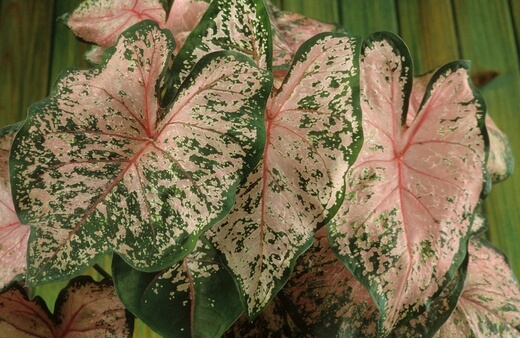
Do caladiums come back every year?
Caladiums are long-lived perennials, and will come back year after year. If your plants are beginning to fade, refresh their compost, and split them to reinvigorate the roots and promote fresh new top growth.
Do caladiums like sun or shade?
Caladiums do best in bright, indirect light, where they benefit from high temperatures without too much beating sun to compete with for moisture. The more shade you can provide, the longer their moisture levels will stay stable, and the easier it will be to prevent fungal problems in their relatively damp growing conditions.
How many years do caladiums last?
Caladiums go on producing gorgeous foliage for well decades, without any need to replace your plants. Like any herbaceous tuberous perennial though, it is a good idea to thin out your borders, and split plants occasionally to prevent hollow sections of planting.
Are caladiums high maintenance?
I would say, from personal experience, that caladiums are fairly low maintenance, but definitely higher maintenance than most dramatic foliage you can plant around the house and garden.
Their moisture balancing act is tricky enough, but once you find the right spot, they rarely need ongoing intervention.
Wrapping Up Our Caladium Growing Guide
Growing caladium at home is a great way to have a bit of fun with your garden design skills. Set your yard apart from your neighbours with statement foliage by choosing the best caladiums, and finding something a little bit different. If you live in warmer parts of Australia, consider planting swathes in borders for high impact.
In cooler parts of the country, stick to containers, and use caladiums to brighten up your patio through spring and summer, with the bonus of colourful winter foliage indoors after that.
Published on December 3, 2022 by Maisie Blevins
Last Updated on February 25, 2025




